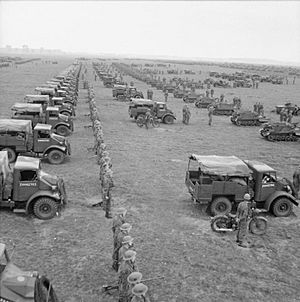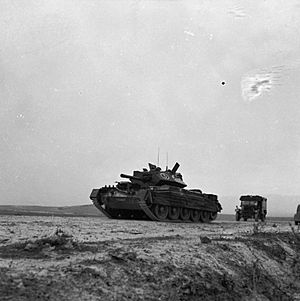6th Armoured Division (United Kingdom) facts for kids
Quick facts for kids 6th Armoured Division |
|
|---|---|
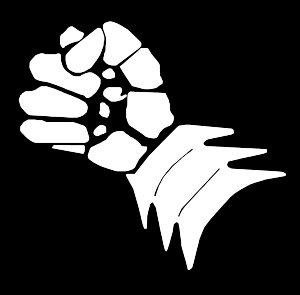
Formation Sign of the 6th Armoured Division.
|
|
| Active | 1940–1945 1951–1958 |
| Country | |
| Branch | |
| Type | Armoured Division |
| Size | Second World War 14,964 men 343 tanks |
| Engagements | Tunisia Campaign Italian Campaign |
| Commanders | |
| Notable commanders |
Sir John Crocker Herbert Lumsden Charles Keightley Sir Gerald Templer |
| Insignia | |
| Insignia | Mailed Fist |
The 6th Armoured Division was a special unit of the British Army. It was made up of tanks and other armoured vehicles. This division was first created in September 1940 during World War II. After the war, it was formed again in May 1951 in the UK.
Contents
History of the 6th Armoured Division
The 6th Armoured Division was officially formed in the United Kingdom on September 12, 1940. Its first leader was Major-General John Crocker. He was an expert in tanks and had fought in the Battle of France.
At first, the division had two armoured brigades and a support group. In April 1942, one armoured brigade left and was replaced by the 38th (Irish) Infantry Brigade. The support group was also removed. The division, now led by Major-General Charles Keightley, began intense training for fighting overseas.
Tanks and Early Battles
The division received different types of tanks over time. In October 1940, they got Matilda tanks. Later, they used Crusader and Valentine tanks. By March 1943, they were given M4A2 Sherman tanks. These Shermans were much better and helped them compete with German tanks.
In November 1942, the division took part in Operation Torch. This was a big landing operation in North Africa. They landed in Bone, close to the enemy forces. They soon saw their first real fighting as part of the British First Army in the Tunisia Campaign. By March 1943, most units had the new Sherman tanks. After fighting in Tunisia, the division moved to the Italian Campaign. They ended the war in Austria.
The Battle of Kasserine Pass
On January 30, 1943, German and Italian forces attacked French units in Tunisia. The Germans were led by Generalfeldmarschall Erwin Rommel, a famous commander.
On February 19, 1943, Rommel launched the Battle of Kasserine Pass. The German and Italian forces pushed through American defenses. The American forces lost many soldiers and tanks. The Italian 131st Centauro Armoured Division captured over 3,000 American soldiers.
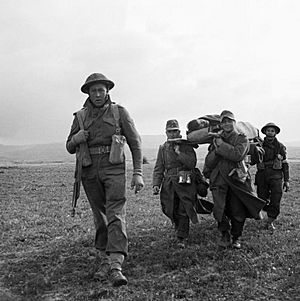
On February 21, the 6th Armoured Division and the 46th Infantry Division arrived to help the American forces. They had been fighting Germans elsewhere. The next day, German attacks continued, but American artillery made it harder for them.
Rommel decided to stop the attack and pull back on February 22. He heard that the Eighth Army was getting close to another German defense line. The Axis forces reached this line on February 25.
After Kasserine, the 6th Armoured Division was reorganized and fully equipped with the powerful M4 Sherman tank. In May 1943, the division led the final attack by the First Army. They broke through to Tunis. The 6th Armoured Division then helped capture all Axis forces in North Africa.
Fighting in Italy
Fighting in Italy was very different from North Africa. There were no wide-open spaces for fast tank movements. The division spent a lot of time helping the infantry (foot soldiers). They had to fight through many enemy defense lines.
The 6th Armoured Division, now led by Major-General Gerald Templer, became part of the XIII Corps. This corps was assigned to the US Fifth Army. They fought in the high Apennine Mountains during Operation Olive in August and September 1944. The Germans had a strong defense line called the Gothic Line. The 6th Armoured Division captured the San Godenzo Pass on September 18.
Spring 1945 Offensive
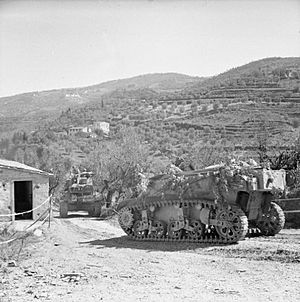
By April 19, 1945, the Argenta Gap was opened. The 6th Armoured Division moved quickly to the northwest. Their goal was to link up with units of the Fifth Army and surround the German divisions defending Bologna.
The Germans fought hard, but Bondeno was captured on April 23. The 6th Armoured Division met the US 10th Mountain Division the next day. This completed the encirclement of the German forces. Bologna was entered by Polish troops on April 21, followed by US forces.
After the War
After World War II, the division moved to the Trieste area. In July 1946, it was renamed the 1st Armoured Division. The division was later sent to Palestine and was officially ended in September 1947.
A new 6th Armoured Division was formed in May 1951 in the UK. It was later sent to Germany as part of the British Army of the Rhine. This new division was disbanded in June 1958.
Leaders of the 6th Armoured Division
Here are some of the important commanders who led the 6th Armoured Division:
| When they started | General Officer Commanding |
| 27 September 1940 | Major-General John Crocker |
| 9 January 1941 | Brigadier Evelyn Fanshawe (acting) |
| 22 February 1941 | Major-General John Crocker |
| 15 October 1941 | Major-General Herbert Lumsden |
| 29 October 1941 | Major-General Charles Gairdner |
| 19 May 1942 | Major-General Charles Keightley |
| 19 December 1943 | Major-General Vyvyan Evelegh |
| 15 February 1944 | Brigadier William Edward Gordon Hemming (acting) |
| 19 March 1944 | Major-General Vyvyan Evelegh |
| 24 July 1944 | Major-General Gerald Templer (wounded 5 August 1944) |
| 5 August 1944 | Brigadier C.A.M.D. Scott (acting) |
| 13 August 1944 | Brigadier Francis Mitchell (acting) |
| 21 August 1944 | Major-General Horatius Murray |
| 27 July 1945 | Brigadier Adrian Gore |
| January 1946 | Major-General Charles Loewen |
| October 1953 | Major-General Francis Mitchell |
| 1955 | Major-General Roderick McLeod |
| 1957 | Major-General Denis O'Connor |
See also
- List of British divisions in World War II
- British Armoured formations of World War II


